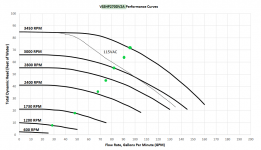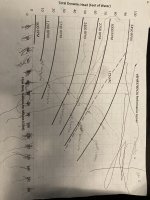All-
Just enjoying our new pool, still trying to find that sweet spot of speed where the heater still has no issue and the sheer descents still look good. Slapped in a shiny new Blue White F300 in a very long straight pipe run after the filter, and took some initial measurements:
So, I'm almost half as efficient at 3450 rpm as I am at 2500 rpm. Will test out 2250 and 2000 tomorrow.
---updated---
Just enjoying our new pool, still trying to find that sweet spot of speed where the heater still has no issue and the sheer descents still look good. Slapped in a shiny new Blue White F300 in a very long straight pipe run after the filter, and took some initial measurements:
| RPM | Reported wattage (with some wiggle room) | Flow (as best I could tell) | "Efficiency" (watts/GPM) (actually, reverse of efficiency, so, "cost of flow") | Notes |
| 600 | 30 | N/A | N/A | |
| 1200 | 131 | 29gpm | 4.52 | sheers dribbling |
| 1750 | 327 | 48gpm | 6.81 | bumpy sheers |
| 2400 | 768 | 65gpm | 11.82 | 2 solid sheers, 1 bumpy |
| 2500 | 848 | 68gpm | 12.47 | |
| 2750 | 1131 | 75gpm | 15.08 | |
| 2800 | 1171 | 78gpm | 15.01 | |
| 3000 | 1437 | 82gpm | 17.52 | |
| 3250 | 1771 | 90gpm | 19.68 | |
| 3450 | 2092 | 95gpm | 22.02 |
So, I'm almost half as efficient at 3450 rpm as I am at 2500 rpm. Will test out 2250 and 2000 tomorrow.
---updated---
Last edited:




